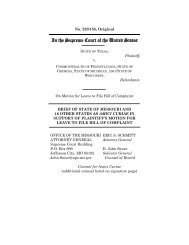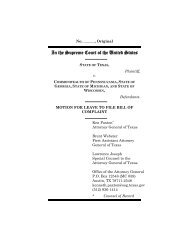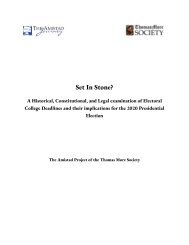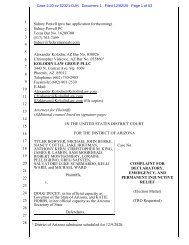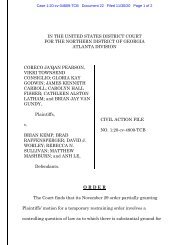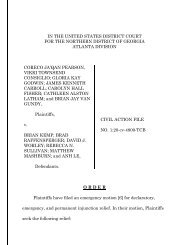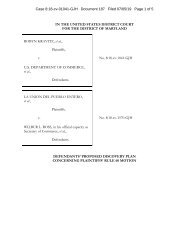Arizona Kraken lawsuit
Kraken lawsuit against gov and sec state filed on December 2, 2020--Highlights o Mismatched signature o No access for poll watchers o No chain of custody o Lowering of signature verification standards (15 points of similarity to none) o Exact same signatures on different mail-in envelopes o Duplicated ballots that were switched from Trump to Biden (duplicated ballots are damaged ballots that are manually copied onto clean ballots) o Trump overvotes were rejected (e.g., Trump voter fills in Trump bubble and handwrites "Donald Trump for President") o Destroyed Trump ballots (returned ballots being counted as unreturned ballots) o Unreturned ballots voted by someone other than the person to whom they were sent o Out of state votes (illegal) o Software settings can make votes “disappear” o Host of other Dominion issues that require expert testimony and analysis
Kraken lawsuit against gov and sec state filed on December 2, 2020--Highlights
o Mismatched signature
o No access for poll watchers
o No chain of custody
o Lowering of signature verification standards (15 points of similarity to none)
o Exact same signatures on different mail-in envelopes
o Duplicated ballots that were switched from Trump to Biden (duplicated ballots are damaged ballots that are manually copied onto clean ballots)
o Trump overvotes were rejected (e.g., Trump voter fills in Trump bubble and handwrites "Donald Trump for President")
o Destroyed Trump ballots (returned ballots being counted as unreturned ballots)
o Unreturned ballots voted by someone other than the person to whom they were sent
o Out of state votes (illegal)
o Software settings can make votes “disappear”
o Host of other Dominion issues that require expert testimony and analysis
Create successful ePaper yourself
Turn your PDF publications into a flip-book with our unique Google optimized e-Paper software.
Case 2:20-cv-02321-DJH Document 1 Filed 12/02/20 Page 25 of 53<br />
1<br />
2<br />
3<br />
4<br />
5<br />
6<br />
7<br />
8<br />
9<br />
10<br />
11<br />
12<br />
13<br />
14<br />
15<br />
16<br />
17<br />
18<br />
19<br />
20<br />
21<br />
22<br />
23<br />
24<br />
This joint cybersecurity advisory was coauthored by the Cybersecurity and<br />
Infrastructure Security Agency (CISA) and the Federal Bureau of<br />
Investigation (FBI). CISA and the FBI are aware of an Iranian advanced<br />
persistent threat (APT) actor targeting U.S. state websites to include<br />
election websites. CISA and the FBI assess this actor is responsible for the<br />
mass dissemination of voter intimidation emails to U.S. citizens and the<br />
dissemination of U.S. election-related disinformation in mid-October<br />
2020. 1 (Reference FBI FLASH message ME-000138-TT, disseminated<br />
October 29, 2020). Further evaluation by CISA and the FBI has identified<br />
the targeting of U.S. state election websites was an intentional effort to<br />
influence and interfere with the 2020 U.S. presidential election.<br />
(See CISA and FBI Joint Cyber Security Advisory of October 30, 2020, a copy attached<br />
hereto as Ex. 18.)<br />
c. Expert Witness Testimony on Dominion Vulnerability to<br />
Foreign Interference and Ties to Hostile Foreign<br />
Governments<br />
77. A PhD Declarant analyzed the cumulative vote percentages sorted by ward<br />
or precinct sizes. This concept was previously used throughout the report on voter<br />
irregularities in lulu Fries’dat and Anselmo Sampietro’s “An electoral system in crisis” at<br />
http://www. electoralsystemincrisis.org/. In Fries’ dat’s report there was an anomalous<br />
dependency on precinct size in many of the 2016 primary elections. The larger precincts<br />
had introduced the use of voting machines.<br />
However, one could also theorize the<br />
opportunity for cheaters to cheat in small precincts, where there may be less oversight.<br />
Normally, we would expect the cumulative vote percentage to converge to an asymptote,<br />
and bounce around the mean until convergence. An example of this can be found from the<br />
2000 Florida Democratic presidential primary between Gore and Bradley. (See Exh. __, at<br />
p. 8). This is shown in Figure 8, and is taken from Fries’ dat’s report:<br />
25<br />
26<br />
27<br />
28<br />
- 25 -





